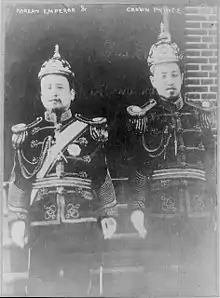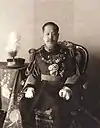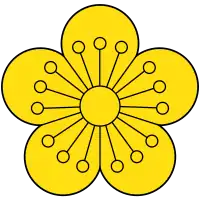Sunjong of Korea
Sunjong, the Emperor Yunghui (Korean: 융희제; Hanja: 隆熙帝; RR: Yunghuije; MR: Yunghŭije; 25 March 1874 – 24 April 1926) also known pejoratively as Chinilpa Yunghui ((Korean: 친일파, lit. "pro-Japan faction Yunghui"),[1][lower-alpha 1][2][3] was the second and the last Emperor of Korea, of the Yi dynasty, ruling from 1907 until 1910.
| Sunjong of Korea 대한제국 순종 大韓帝國純宗 | |||||||||||||
|---|---|---|---|---|---|---|---|---|---|---|---|---|---|
 | |||||||||||||
| Emperor of Korea | |||||||||||||
| Reign | 19 July 1907 – 29 August 1910 | ||||||||||||
| Predecessor | Gojong of Korea | ||||||||||||
| Successor | Position abolished (Terauchi Masatake as Governor General of Japanese Korea) | ||||||||||||
| Crown Prince of Korea | |||||||||||||
| Reign | 13 October 1897 – 19 July 1907 | ||||||||||||
| Predecessor | Title established | ||||||||||||
| Successor | Crown Prince Euimin | ||||||||||||
| Crown Prince of Joseon | |||||||||||||
| Reign | 1876 – 13 October 1897 | ||||||||||||
| Predecessor | Crown Prince Hyomyeong | ||||||||||||
| Successor | Title abolished | ||||||||||||
| Born | 25 March 1874 Changdeok Palace, Hanseong, Joseon dynasty of Korea | ||||||||||||
| Died | 24 April 1926 (aged 52) Changdeok Palace, Keijō, Japanese Korea | ||||||||||||
| Burial | |||||||||||||
| Spouse | |||||||||||||
| |||||||||||||
| House | House of Yi | ||||||||||||
| Father | Gojong of Korea | ||||||||||||
| Mother | Empress Myeongseong | ||||||||||||
| Korean name | |
| Hangul | |
|---|---|
| Hanja | |
| Revised Romanization | Sunjong Yunghuije |
| McCune–Reischauer | Sunjong Yung'huije |
| Pen name | |
| Hangul | 정헌 |
| Hanja | 正軒 |
| Revised Romanization | Jeongheon |
| McCune–Reischauer | Chŏnghŏn |
| Birth name | |
| Hangul | 이척 |
| Hanja | 李坧 |
| Revised Romanization | I Cheok |
| McCune–Reischauer | Yi Ch'ŏk |
| Courtesy name | |
| Hangul | 군방 |
| Hanja | 君邦 |
| Revised Romanization | Gunbang |
| McCune–Reischauer | Kunbang |
Biography
Sunjong was the second son of Emperor Gojong and Empress Myeongseong. When he became two years old in 1876, Sunjong was proclaimed the Crown Prince of Joseon. In 1882, he married a daughter of the Yeoheung Min clan, who later became Empress Sunmyeonghyo (Korean: 순명효황후; Hanja: 純明孝皇后). She later died at the age of 31 on 5 November 1904 due to the severe depression she got from trying to protect his mother of her assassination on 8 October 1895.
The Korean Empire was established in 1897, and Sunjong became the imperial crown prince. Sunjong remarried again 3 years later to Yun Jeong-sun of the Haepyeong Yun clan, who was 20 years his junior, on 24 January 1907, and became Crown Princess Consort Yun (later Empress Sunjeong). In 19 July 1907, Gojong was deposed as a result of Japanese coercion, and Sunjong was made Emperor of Korea. He was proclaimed heir to the throne of Prince Imperial Yeong (Korean: 영친왕; Hanja: 英親王), the younger half-brother of Sunjong, and moved from Deoksugung Palace to the imperial residence at Changdeokgung Palace.[4]
Sunjong's reign was limited by the gradually increasing armed intervention of the Japanese government in Korea. In July 1907, he was proclaimed emperor of Korea but was immediately forced to enter into the Japan–Korea Treaty of 1907 (Korean: 한일신협약, 정미7조약; Hanja: 韓日新協約, 丁未七條約). This treaty allowed the Japanese government to supervise and intervene in the administration and governance of Korea, which also allowed for the appointment of Japanese ministers within the government.[5]
While under Japanese supervision, the Korean army was dismissed on the pretext of lack of public finance regulations. In 1909, Japan implemented the Japan–Korea Protocol (Korean: 기유각서; Hanja: 己酉覺書) which effectively removed Korea's judicial power. Meanwhile, Japan dispatched Itō Hirobumi, Japanese Resident-General of Korea, to negotiate with Russia over problems involving Korea and Manchuria. However, Itō was assassinated by Ahn Jung-geun at Harbin, which led to the Japanese annexation of Korea in 1910. Pro-Japanese politicians, such as Song Byung-jun and Lee Wan-yong, defected, merging Korea with Japan by fabricating Korea's willingness and establishing the Japan–Korea Annexation Treaty on August 29, 1910.[6][7]
Although still existent on paper, the intervention by the Japanese government effectively ended Sunjong's reign over the Korean Empire and he became essentially powerless within three years of ruling. Japan, in effect, abolished the Korean Empire on August 29, 1910, ending 519 years of the Joseon dynasty.[8]
After abdication
After the annexation treaty, the former Emperor Sunjong and his wife, Empress Sunjeong, lived the rest of their lives virtually imprisoned in Changdeokgung Palace in Seoul.[9] Sunjong could not exercise any power as emperor because there were only pro-Japanese politicians in government. After the Korean Empire collapsed, Sunjong was demoted from emperor to king. Japan allowed him the title of King Yi of Changdeok Palace (Korean: 창덕궁 이왕; Hanja: 昌德宮 李王) and allowed for the title to be inherited.[4]
Sunjong died on April 24, 1926, in Changdeokgung and is buried with his two wives at the imperial tomb of Yureung (유릉, 裕陵) in the city of Namyangju. His state funeral on June 10, 1926, was a catalyst for the June 10th Movement against Japanese rule. He had no children.[10]
Family
- Great-Great-Great-Great-Great-Grandfather
- Yi Hyeok, Prince Eui (이혁 의원군, 義原君 李爀) (13 June 1661 – 12 November 1722)
- Adoptive-Great-Great-Great-Great-Great-Grandfather: Yi Hwan, Prince Yang (이환 양원군, 李煥 陽原君) (April 1658 – March 1724)
- Yi Hyeok, Prince Eui (이혁 의원군, 義原君 李爀) (13 June 1661 – 12 November 1722)
- Great-Great-Great-Great-Great-Grandmother
- Princess Consort Kwon of the Andong Kwon clan (군부인 안동권씨) (27 August 1664 – 7 April 1735)
- Adoptive-Great-Great-Great-Great-Great-Grandmother: Princess Consort Min of the Yeoheung Min clan (군부인 여흥 민씨)
- Princess Consort Kwon of the Andong Kwon clan (군부인 안동권씨) (27 August 1664 – 7 April 1735)
- Great-Great-Great-Great-Grandfather
- Yi Suk, Prince Anheung (이숙 안흥군, 李俶 安興君) (9 October 1693 – 7 April 1768)
- Great-Great-Great-Great-Grandmother
- Princess Consort Ryu of the Munhwa Ryu clan (군부인 문화류씨) (3 January 1696 – 13 January 1755)
- Great-Great-Great-Grandfather
- Yi Jin-ik (이진익, 李鎭翼) (25 September 1728 – 26 April 1796)
- Great-Great-Great-Grandmother
- Lady Jo of the Hanyang Jo clan (본관: 한양조씨); (조도건의 딸) daughter of Jo Do-gyeon (조도건, 趙道健)
- Great-Great-Grandfather
- Yi Byeong-won (6 April 1752 – 11 November 1822) (이병원, 李秉源)
- Adoptive-Great-Great-Grandfather: Yi Jin, Prince Eunsin (이진 은신군, 李禛 恩信君) (11 January 1755 – 29 March 1771)
- Yi Byeong-won (6 April 1752 – 11 November 1822) (이병원, 李秉源)
- Great-Great-Grandmother
- Lady Jeong of the Yeonil Jeong clan (본관: 연일 정씨); (정의환의 딸) daughter of Jeong Eui-hwan (정의환, 鄭義煥)
- Adoptive-Great-Great-Grandmother: Princess Consort Namyang of the Namyang Hong clan (남양군부인 남양 홍씨, 南陽郡夫人 南陽 洪氏) (1755 – 21 March 1829)
- Lady Jeong of the Yeonil Jeong clan (본관: 연일 정씨); (정의환의 딸) daughter of Jeong Eui-hwan (정의환, 鄭義煥)
- Great-Grandfather
- Yi Gu, Prince Namyeon (22 August 1788 – 19 March 1836) (이구 남연군, 南延君)
- Great-Grandmother
- Princess Consort Min of the Yeoheung Min clan (26 June 1788 – 1831) (군부인 여흥민씨, 驪興府大夫人 閔氏)
- Grandfather
- Yi Ha-Eung, Grand Internal Prince Heungseon (21 December 1820 – 22 February 1898) (이하응 흥선대원군)
- Adoptive Grandfather: Crown Prince Hyomyeong (18 September 1809 – 25 June 1830) (이영 효명세자)
- Yi Ha-Eung, Grand Internal Prince Heungseon (21 December 1820 – 22 February 1898) (이하응 흥선대원군)
- Grandmother
- Grand Internal Princess Consort Sunmok of the Yeoheung Min clan (3 February 1818 – 8 January 1898) (순목대원비 민씨)
- Adoptive Grandmother: Queen Shinjeong of the Pungyang Jo clan (21 January 1809 – 4 June 1890) (신정왕후 조씨)
- Grand Internal Princess Consort Sunmok of the Yeoheung Min clan (3 February 1818 – 8 January 1898) (순목대원비 민씨)
- Father
- Emperor Gojong (고종) (8 September 1852 – 21 January 1919)
- Mother
- Empress Myeongseong of the Yeoheung Min clan (명성황후 민씨) (17 November 1851– 8 October 1895)
- Maternal Grandfather: Min Chi-rok (민치록, 閔致祿) (1799–1858)
- Maternal Grandmother: Lady Hanchang of the Hansan Yi clan (한창부부인 이씨, 韓昌府夫人 李氏) (1818-1874)
- Empress Myeongseong of the Yeoheung Min clan (명성황후 민씨) (17 November 1851– 8 October 1895)
- Brothers
- Older half-brother: Yi Seon, Prince Wanhwa (16 April 1868 – 12 January 1880) (이선 완화군)
- Unnamed older brother (born 4 November 1871 – 8 November 1871)
- Unnamed younger brother (born 5 April 1875 – 18 April 1875)
- Unnamed younger brother (born 18 February 1878 – 5 June 1878)
- Younger half-brother: Yi Kang, Prince Uihwa (30 March 1877 – August 1955) (이강 의화군)
- Younger half-brother: Yi Eun, Crown Prince Uimin (20 October 1897 – 1 May 1970) (이은 의민태자)
- Younger half-brother: Prince Yi Yuk (3 July 1914 – 22 January 1915) (이육)
- Younger half-brother: Prince Yi U (20 August 1915 – 25 July 1916) (이우)
- Sisters
- Unnamed older half-sister (born 1871–1872)
- Unnamed older sister (born 13 February 1873 – 28 September 1873)
- Unnamed younger half-sister (born 1879–1880)
- Younger half-sister: Princess Deokhye (25 May 1912 – 21 April 1989) (덕혜옹주, 德惠翁主)
- Consorts:
- Empress Sunmyeong of the Yeoheung Min clan (순명황후 민씨) (20 November 1872– 5 November 1904) – born to Min Tae-ho, leader of the Yeoheung Min clan; relative of Empress Myeongseong. She died before her husband was enthroned.
- Empress Sunjeong of the Haepyeong Yun clan (순정황후 윤씨) (19 September 1894– 3 February 1966) – daughter of Marquis Yun Taek-yeong.
Honours
.svg.png.webp) Korea: Founder of the Order of the Auspicious Phoenix(서봉장,瑞鳳章)[lower-alpha 2][11]
Korea: Founder of the Order of the Auspicious Phoenix(서봉장,瑞鳳章)[lower-alpha 2][11].svg.png.webp) Japan: Grand Cordon of the Order of the Chrysanthemum – 16 January 1901; Collar – 17 October 1907[12]
Japan: Grand Cordon of the Order of the Chrysanthemum – 16 January 1901; Collar – 17 October 1907[12].svg.png.webp) Belgium: Grand Cordon of the Royal Order of Leopold
Belgium: Grand Cordon of the Royal Order of Leopold
Ancestry
| Ancestors of Sunjong of Korea | |||||||||||||||||||||||||||||||||||||||||||||||||||||||||||||||||||||||||||||||||||||||||||||||||||||||||||||||||||||||||||||||||||||||||||||||||||||||||||||||||||||||||||||||||||||||||||||||||||||||||||||||||||||||||||||||||||||||||||||||||||||||||||||||||||||||||||||||||||||||||||||||||||||||||||||||||||||||||||||||||||||||||||||||||||||||||||||||||||||||||||||||||||||||||||||||||||||||||||||||||||||||||||||||||||||||||||||||||||||||||||||||||||||||||||||||||||||||||||||||||||||||||||||||||||||||||||||||||||||||||||||||||||||||||||||
|---|---|---|---|---|---|---|---|---|---|---|---|---|---|---|---|---|---|---|---|---|---|---|---|---|---|---|---|---|---|---|---|---|---|---|---|---|---|---|---|---|---|---|---|---|---|---|---|---|---|---|---|---|---|---|---|---|---|---|---|---|---|---|---|---|---|---|---|---|---|---|---|---|---|---|---|---|---|---|---|---|---|---|---|---|---|---|---|---|---|---|---|---|---|---|---|---|---|---|---|---|---|---|---|---|---|---|---|---|---|---|---|---|---|---|---|---|---|---|---|---|---|---|---|---|---|---|---|---|---|---|---|---|---|---|---|---|---|---|---|---|---|---|---|---|---|---|---|---|---|---|---|---|---|---|---|---|---|---|---|---|---|---|---|---|---|---|---|---|---|---|---|---|---|---|---|---|---|---|---|---|---|---|---|---|---|---|---|---|---|---|---|---|---|---|---|---|---|---|---|---|---|---|---|---|---|---|---|---|---|---|---|---|---|---|---|---|---|---|---|---|---|---|---|---|---|---|---|---|---|---|---|---|---|---|---|---|---|---|---|---|---|---|---|---|---|---|---|---|---|---|---|---|---|---|---|---|---|---|---|---|---|---|---|---|---|---|---|---|---|---|---|---|---|---|---|---|---|---|---|---|---|---|---|---|---|---|---|---|---|---|---|---|---|---|---|---|---|---|---|---|---|---|---|---|---|---|---|---|---|---|---|---|---|---|---|---|---|---|---|---|---|---|---|---|---|---|---|---|---|---|---|---|---|---|---|---|---|---|---|---|---|---|---|---|---|---|---|---|---|---|---|---|---|---|---|---|---|---|---|---|---|---|---|---|---|---|---|---|---|---|---|---|---|---|---|---|---|---|---|---|---|---|---|---|---|---|---|---|---|---|---|---|---|---|---|---|---|---|---|---|---|---|---|---|---|---|---|---|---|---|---|---|---|---|---|---|---|---|---|---|---|---|---|---|---|---|---|---|---|---|---|---|---|---|---|---|---|---|---|---|---|---|---|---|---|---|---|---|---|---|---|---|---|---|---|---|---|---|---|---|---|---|---|---|---|---|---|---|---|---|---|---|---|---|---|---|---|---|---|---|---|---|---|---|---|---|---|---|---|---|---|---|---|---|---|---|---|---|---|---|---|---|---|---|---|---|---|---|---|---|---|---|---|---|---|---|---|---|---|---|---|---|---|---|---|---|---|---|---|---|---|---|---|---|---|---|---|---|---|---|---|
| |||||||||||||||||||||||||||||||||||||||||||||||||||||||||||||||||||||||||||||||||||||||||||||||||||||||||||||||||||||||||||||||||||||||||||||||||||||||||||||||||||||||||||||||||||||||||||||||||||||||||||||||||||||||||||||||||||||||||||||||||||||||||||||||||||||||||||||||||||||||||||||||||||||||||||||||||||||||||||||||||||||||||||||||||||||||||||||||||||||||||||||||||||||||||||||||||||||||||||||||||||||||||||||||||||||||||||||||||||||||||||||||||||||||||||||||||||||||||||||||||||||||||||||||||||||||||||||||||||||||||||||||||||||||||||||
Gallery
 Emperor Gojong and the Crown Prince Sunjong
Emperor Gojong and the Crown Prince Sunjong Sunjong wearing Court uniform and dress in the Empire of Japan and Japanese honors
Sunjong wearing Court uniform and dress in the Empire of Japan and Japanese honors Sunjong wearing Court uniform and dress of the Empire of Japan, Japanese honors and Collar of the Supreme Order of the Chrysanthemum
Sunjong wearing Court uniform and dress of the Empire of Japan, Japanese honors and Collar of the Supreme Order of the Chrysanthemum
See also
- List of Korea-related topics
- History of Korea
- Korean Empire
- Rulers of Korea
- House of Yi
Notes
- sunjong was born in february 8th 1874 in the lunar calendar.However in 1908, when the emperor's birthday was made into a public holiday called geonwonjeol(乾元節), the date has been converted to a solar calendar.
- The order was established by the emperor's orders in 1907.
References
- "Chinilpa - Unionpedia, the concept map". en.unionpedia.org. Retrieved 16 January 2021.
- http://encykorea.aks.ac.kr/Contents/Item/E0002014
- http://encykorea.aks.ac.kr/Contents/Item/E0031947
- "The Academy of Korean Studies(한국학중앙연구원) : 순종(Sunjong)".
- 『고종시대사 6』(History of Gojong's Period 6) : 국사편찬위원회(National History Compilation Committee), 1969, 635p.
- 『고종시대사 6』(History of Gojong's Period 6) : 국사편찬위원회(National History Compilation Committee), 1969, 641p.
- Rhee, Song Nai. Beautiful as the Rainbow: Nashimoto Masako, a Japanese Princess against All ... p. 100.
- "::: Cultural Heritage, the source for Koreans' Strength and Dream :::". Cultural Heritage Administration of Korea. Retrieved 2 September 2013.
- "Emperor Sunjong of Korea". Asian History. Retrieved 2 September 2013.
- Yunghui Yi Cheok, Emperor Sunjong. Korea's Last Emperor's Goodbye: Korea Annexed by Japan. 1915.
- http://encykorea.aks.ac.kr/Contents/Item/E0027776
- 刑部芳則 (2017). 明治時代の勲章外交儀礼 (PDF) (in Japanese). 明治聖徳記念学会紀要. pp. 149, 150.
Sunjong of Korea Born: 25 March 1874 Died: 24 April 1926 | ||
| Regnal titles | ||
|---|---|---|
| Preceded by Gojong |
Emperor of Korea 19 July 1907 – 29 August 1910 |
Empire dissolved Annexed by Japan |
| Royal titles | ||
| New title |
King Yi (Changdeokgung) 29 August 1910 – 24 April 1926 |
Succeeded by Yi Un |
| Titles in pretence | ||
| Loss of title | — TITULAR — Emperor of Korea 29 August 1910 – 24 April 1926 Reason for succession failure: Empire abolished in 1910 |
Succeeded by Crown Prince Euimin |
.jpg.webp)
